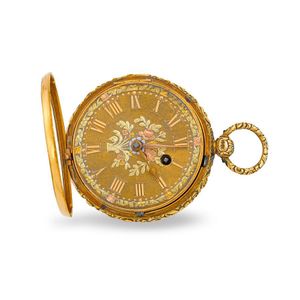1877 Gold Hunter Case Pocket Watch with Fusee Movement
You must be a subscriber, and be logged in to view price and dealer details.
Subscribe Now to view actual auction price for this item
When you subscribe, you have the option of setting the currency in which to display prices to $Au, $US, $NZ or Stg.
- Hunter - A hunter pocket watch is the type where the case includes a spring-hinged circular metal lid or cover, that closes over the glass face of the watch, protecting it from dust, scratches and other damage or debris. The majority of antique and vintage hunter-case watches have the lid-hinges at the 9 o?clock position, suiting the right handed user.
- Victorian Period - The Victorian period of furniture and decorative arts design covers the reign of Queen Victoria from 1837 to 1901. There was not one dominant style of furniture in the Victorian period. Designers used and modified many historical styles such as Gothic, Tudor, Elizabethan, English Rococo, Neoclassical and others, although use of some styles, such as English Rococo and Gothic tended to dominate the furniture manufacture of the period.
The Victorian period was preceded by the Regency and William IV periods, and followed by the Edwardian period, named for Edward VII (1841 ? 1910) who was King of the United Kingdom and the British Dominions and Emperor of India for the brief period from 1901 until his death in 1910. - Movement - The technical name for the workings of a clock or watch, and does not include the dial or case.
- Fusee - The fusee movement was used in clocks and pocket watches from the mid 17th century. The fusee is a cone shaped drum within the works that is linked to the barrel of the spring, usually by a length of chain.
As the mainspring loses its tension over time, the cone shaped barrel compensates for this by increasing the tension, by pulling the mainspring tighter, thus ensuring the time remains constant.
Use of the fusee in clocks was superseded by the "going barrel" in the mid 19th century and for pocket watches at the beginning of the 19th century.
The fusee continued to be used in marine chronometers until the 1970s.
This item has been included into following indexes:
Visually similar items

A Swiss keyless gold hunter cased quarter repeat pocket watch, hallmarked and stamped 18ct gold case c.1895, showing dents on all covers. 1/4 repeating movement by Henry Sandoz N.35974 in working order. Enamel dial very faint hairlines. Diameter 52 mm. TW

A good Swiss 'Baume' gold hunter repeating pocket watch, hallmarked and stamped 18ct gold case. Chronograph quarter repeating movement with subsidiary seconds and minutes dials. Jewelled to the centre (needs adjusting). Diameter 53 mm, TW 141gms.

Lady's 9ct gold full hunter pocket watch, engraved golden dial with Roman numerals stem wind, push piece at 4 o'clock, not working, wt. 22.5g.

An ornate 18ct tri-colour gold openfaced pocketwatch English circa 1840, English fusee verge movement, engine-turned tri-colour gold dial with Roman numerals, centre bouquet and outer foliate detail, spade hands, engine-turned case with chased and engraved
